The Ultimate Halloween Party Movie: House of Frankenstein
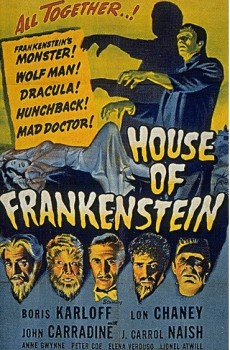 House of Frankenstein (1944)
House of Frankenstein (1944)
Directed by Erle C. Kenton. Starring Boris Karloff, Lon Chaney Jr., John Carradine, J. Carrol Naish, Glenn Strange, Anne Gwynne, Elena Verdugo, George Zucco, Lionel Atwill.
I was working in the lab, late one night…
Ah, October. My favorite month. No other time is so ideal for exploring dark fantasy, the Gothic, the classic ghost story … and of course, Universal horror films. The monsters of Universal’s 1930s and ‘40s films have given the Halloween season its mascots, creatures as closely identified with the holiday as Santa Claus is with Christmas. So there’s no better Halloween party flick than the wall-to-wall monster epic that was the original “The Monster Mash”…
In seventy-one minutes, House of Frankenstein brings you:
- Dracula
- The Wolf Man
- Frankenstein’s Monster
- A mad scientist
- A hunchback
- A torch-wielding mob of angry villagers
- A laboratory full of Kenneth Strickfaden-influenced sizzling equipment
- Brain transplants!
All this, plus the hat trick of Boris Karloff, Lon Chaney Jr., and John Carradine in the same film; roles for classic supporting actors Lionel Atwill and George Zucco; and sexy Anne Gwynne. Now how much would you pay?
I paid $8.99 for my DVD, and I got Frankenstein Meets the Wolf Man on the same disc!
Although House of Frankenstein is a chewy piece of nostalgic Halloween candy to us today, in 1944 Universal’s brass probably looked at it as quickie exploitation fare. The studio was coming to the end of its Second Age of Monsters which had started in 1939 with Son of Frankenstein, and cramming as many of their horror icons into one film as possible — whether it made any plot sense or not — was merely a gimmick to milk as much remaining money as they could from the old franchises. Time has been enormously kind to House of Frankenstein: for children watching TV in the 1950s and ‘60, syndicated showings of the movie were the ultimate Saturday afternoon sugar-high, and for adults today the movie has a huge amount of energy and a fun cast to overcome the general haphazard nature of the project.
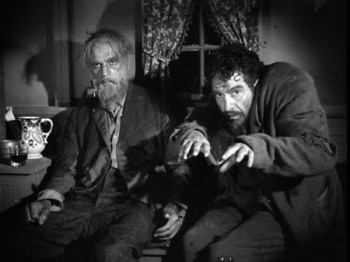 The direct inspiration for House of Frankenstein was the previous year’s Frankenstein Meets the Wolf Man (also known through a common tongue slip as Frankenstein Wolfs the Meat Man), where screenwriter Curt Siodmak threw together Larry Talbot’s werewolf and the shambling construct created by Victor Frankenstein and ended up with a substantial hit and the beginning of “Universal’s Monster Rally.” Siodmak also wrote the story for House of Frankenstein, although not the screenplay, which he said would have required a wizard to make work. Director Erle C. Kenton had previously directed Ghost of Frankenstein and was an efficient B-movie handler who knew how to corral action and keep the project moving. Some of the plot follows the continuity of the previous Wolf Man and Frankenstein movies, and in other places treats “continuity” as a dirty word. (Try to figure out when the movie is supposed to take place. Is it 1880, or 1944? No right answer, but it’s a fun game.)
The direct inspiration for House of Frankenstein was the previous year’s Frankenstein Meets the Wolf Man (also known through a common tongue slip as Frankenstein Wolfs the Meat Man), where screenwriter Curt Siodmak threw together Larry Talbot’s werewolf and the shambling construct created by Victor Frankenstein and ended up with a substantial hit and the beginning of “Universal’s Monster Rally.” Siodmak also wrote the story for House of Frankenstein, although not the screenplay, which he said would have required a wizard to make work. Director Erle C. Kenton had previously directed Ghost of Frankenstein and was an efficient B-movie handler who knew how to corral action and keep the project moving. Some of the plot follows the continuity of the previous Wolf Man and Frankenstein movies, and in other places treats “continuity” as a dirty word. (Try to figure out when the movie is supposed to take place. Is it 1880, or 1944? No right answer, but it’s a fun game.)
The movie went through a series of working titles — The Devil’s Brood, Chamber of Horrors, and Destiny (the generic title slapped on many Universal films during development) — before picking the name of Universal’s most popular creature. Never mind that there’s no “house” of Dr. Frankenstein anywhere in the story. And once again, Universal shows in the title that when it comes to marketing it doesn’t distinguish between the doctor and his creation.
The story is a patchwork of mini-movies hooked together: screenwriter Edward T. Lowe Jr. apparently wasn’t the “wizard” that Siodmak thought the script needed. An opening prologue introduces mad scientist Dr. Gustav Niemann (Boris Karloff) locked up in a prison fortress with his hunchback assistant Daniel (J. Carrol Naish). Niemann has two goals: recover Frankenstein’s notes on the miracle of brain transplantation, and murder the three men responsible for his incarceration. If he can combine the two, all the better! He’s convinced Daniel to help by promising to transplant the deformed man’s brain into a perfect body. An incredibly convenient lightning bolt breaks down the prison wall, allowing the two men to escape. They seize control of the caravan of a traveling “Chamber of Horrors” sideshow, murdering its owner (George Zucco). The sideshow’s main attraction is the skeleton of Count Dracula himself, and this gives Dr. Niemann a wickedly Grinchy idea to kill off the first man on his death list, Bürgermeister Hussman of Reigelberg (Sig Ruman).
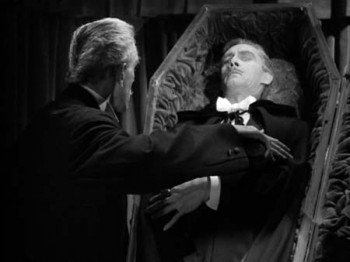 This starts mini-movie #1, starring John Carradine as Dracula. Although Bela Lugosi originated the role at Universal, the studio had little interest in working with him. Lon Chaney Jr. had played Dracula in Son of Dracula, but since here he was needed to play the Wolf Man, his far more famous role, another actor was required. Carradine was a superb choice, and he’s one of my favorite Draculas. It’s unfortunate that he was never given a full Dracula movie, because he has the perfect towering presence and hypnotic command the character needs. Carradine wanted to play the Count closer to the way Stoker’s novel described him, with a long, drooping mustache, but was only permitted a smaller and more urbane one. He drops the Transylvanian accent (really, only Lugosi could make that sound good and not a parody) and gives his Dracula a touch of the aristocratic southern gentleman, akin to his gambler in Stagecoach.
This starts mini-movie #1, starring John Carradine as Dracula. Although Bela Lugosi originated the role at Universal, the studio had little interest in working with him. Lon Chaney Jr. had played Dracula in Son of Dracula, but since here he was needed to play the Wolf Man, his far more famous role, another actor was required. Carradine was a superb choice, and he’s one of my favorite Draculas. It’s unfortunate that he was never given a full Dracula movie, because he has the perfect towering presence and hypnotic command the character needs. Carradine wanted to play the Count closer to the way Stoker’s novel described him, with a long, drooping mustache, but was only permitted a smaller and more urbane one. He drops the Transylvanian accent (really, only Lugosi could make that sound good and not a parody) and gives his Dracula a touch of the aristocratic southern gentleman, akin to his gambler in Stagecoach.
Dr. Niemann revives Dracula when he pulls the stake from the heart of the Count’s skeleton. A grateful and oddly subservient King of the Vampires agrees to kill Bürgermeister Hussman for Niemann. In the process, Dracula tries seducing Hussman’s grandson’s wife, played by famous pin-up girl Anne Gwynne. The sequence concludes with an exciting coach chase that might have come from one of Universal’s programmer Westerns.
With Dracula out of the picture, Dr. Niemann and Daniel move their caravan on toward Visaria, where the Frankenstein Monster and the Wolf Man vanished in the destruction of the dam that concluded Frankenstein Meets the Wolf Man. They thaw out the two from the ice beneath a ruined castle, although the Monster (Glenn Strange) is nearly powerless. Mini-movie #2 begins at this point, which centers on Lawrence Talbot (Lon Chaney Jr.) and a love triangle involving him, gypsy dancer Ilonka (Elena Verdugo), and Daniel.
Workaholic character actor J. Carrol Naish (who played the first on-screen Batman villain in a 1943 serial) provides the emotional heart of the film in his portrayal of Daniel’s tragic love for Ilonka. Ilonka treats the hunchback tenderly but cannot help her repulsion toward his deformity. The scene where she recoils when she gets her first full-body look at Daniel is the best non-monster moment in the movie. No matter how sweet Ilonka may act toward Daniel after this point, Daniel will not be able to erase the memory of the look of horror on her face.
While Ilonka prepares a silver bullet to kill Lawrence Talbot at his request, Dr. Niemann keeps himself busy with his revenge plans. At this point, Curt Siodmak’s famous predilection for brain-switching plots goes totally berserk. Niemann captures his two remaining enemies, Strauss and Ullman, and then outlines the most outrageous brain-switcheroo in history:
- Ullman’s brain will be put in the body of the Frankenstein Monster to punish him with the monster’s hideousness.
- Lawrence Talbot’s brain will be planted in Strauss’s head, to pass on the werewolf curse.
- The Monster’s brain will be planted in Lawrence Talbot’s skull because, well, why not?
- Ullman’s brainless body will try out for America’s Got Talent.
- Strauss’s bodiless brain will be used as a doorstop.
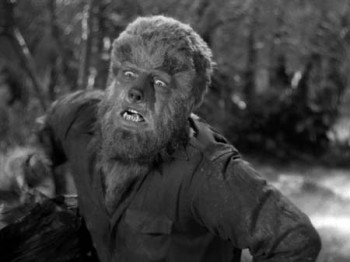 Actually, Niemann doesn’t specify what he wants to do with those last two “leftovers,” and I’m amazed the doctor was able to keep any of this straight. (“Wait, whose brain was this again? Dammit, I’ve got to remember to write on these with a Sharpie!”) Poor Daniel wants to get Talbot’s body so Ilonka will love him, but Niemann insists Talbot will best house the Frankenstein Monster’s brain. Again, I don’t know why this is so, and why preserve the Monster’s brain at all considering how much trouble he’s caused?
Actually, Niemann doesn’t specify what he wants to do with those last two “leftovers,” and I’m amazed the doctor was able to keep any of this straight. (“Wait, whose brain was this again? Dammit, I’ve got to remember to write on these with a Sharpie!”) Poor Daniel wants to get Talbot’s body so Ilonka will love him, but Niemann insists Talbot will best house the Frankenstein Monster’s brain. Again, I don’t know why this is so, and why preserve the Monster’s brain at all considering how much trouble he’s caused?
Actually, this all makes far more sense than another Curt Siodmak brain-switching movie, which also featured Boris Karloff performing some interesting transplants, Black Friday (1940). If anything, all this cerebellum juggling just adds to the amusement.
We now reach the epilogue, when the Frankenstein Monster finally does something aside from lie around on a slab, and the angry mob arrives after a stop at the torch shop. The ending is a real smash-up, with almost all the main characters dying in the space of a few energetic minutes. To hell with subtlety, let’s just kill everybody, break everything, and torch the place.
Glenn Strange, a Western actor who would be a regular on Gunsmoke for twelve years, is a physically impressive Frankenstein Monster with his 6’5” frame. He doesn’t project much empathy in the part, but the movie doesn’t give him much of a chance to do anything aside from causing destruction in the last few minutes. It’s odd having Strange playing the monster across from Karloff, the actor who originated the part thirteen years earlier, and there’s some poignancy in watching Strange drag Karloff toward the swamp at the end: the man who first played Universal’s Frankenstein Monster goes to his death in the clutches of the last man who would play the role.
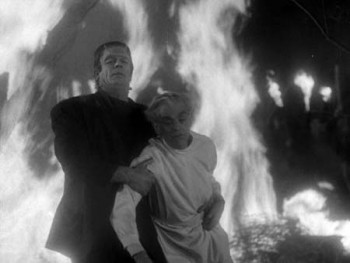 Karloff isn’t spectacular in the part of Dr. Niemann and seems a bit distant. But he’s Boris Karloff in a Universal Horror film, so it hardly matters. He has the voice, he has the authority, and it’s wonderful having him around. Chaney, on the other hand, gives all he can to his part as Larry Talbot. He considered the Wolf Man “his baby,” and he always delivered the right level of hopelessness to the man doomed to the eternity of werewolf transformations and arduous Jack Pierce make-up. It is hard to believe Ilonka would find the gloomy Lawrence Talbot attractive for a moment, but she doesn’t have a good selection of other available men to choose from.
Karloff isn’t spectacular in the part of Dr. Niemann and seems a bit distant. But he’s Boris Karloff in a Universal Horror film, so it hardly matters. He has the voice, he has the authority, and it’s wonderful having him around. Chaney, on the other hand, gives all he can to his part as Larry Talbot. He considered the Wolf Man “his baby,” and he always delivered the right level of hopelessness to the man doomed to the eternity of werewolf transformations and arduous Jack Pierce make-up. It is hard to believe Ilonka would find the gloomy Lawrence Talbot attractive for a moment, but she doesn’t have a good selection of other available men to choose from.
Special effects creator John P. Fulton — the man who wowed the world in 1933 with his trickery in The Invisible Man — does a terrific werewolf transformation scene for Lon Chaney Jr. as he stares into a mirror. The series of lap dissolves hardly show their seams. Fulton also creates an interesting effect bringing Dracula to life, showing his body build up from muscles and veins into the full-bodied vampire. The make-up designs from Jack Pierce for the Wolf Man and the Frankenstein Monster are his standard classics, nothing more than the usual great work.
House of Frankenstein was successful enough in theaters to warrant a sequel the next year using the same monster line-up, House of Dracula, but it doesn’t have the same energetic spark and the Wolf Man is terribly underused. The popular 1948 comedy Bud Abbott Lou Costello Meet Frankenstein (really, that’s the actual on-screen title) was a sequel in spirit, if not in tone, bringing together Dracula (once again played by Bela Lugosi), the Frankenstein Monster, and the Wolf Man (Strange and Chaney Jr. reprising their roles). The Invisible Man (Vincent Price’s voice) drops by for a “cameo.” Can you call it a cameo if you can’t see the character?
House of Frankenstein may seem minor next to Universal’s 1930s originals and 1941’s The Wolf Man, but it’s a giddy bunch of fun with actors you love, monsters you adore, and it holds together as much of the “good stuff” as Universal could give in the later years. And it doesn’t overstay its welcome. For a Halloween party for all ages, it’s a genuine graveyard smash.
Okay, now where did I put that extra brain…
Ryan Harvey is a veteran blogger for Black Gate and an award-winning author. He received the Writers of the Future Award in 2011 for his short story “An Acolyte of Black Spires,” and has two stories forthcoming in Black Gate and a number of ebooks on the way. You can keep up with him at his website, www.RyanHarveyWriter.com and follow him on Twitter.
[…] Destroy All Monsters is anything but mediocre: like Universal’s House of Frankenstein over twenty years before, it pulls together all the science-fiction candy-corn goodness available […]
[…] studio planned to finish off the Godzilla series with a mad monster party, Toho’s own version of House of Frankenstein, and crammed eleven monsters together along with more alien invaders and a toy-ready […]